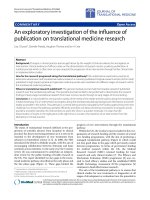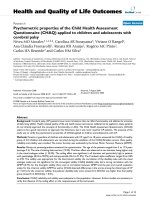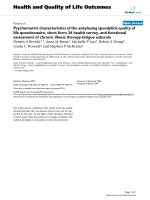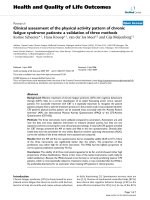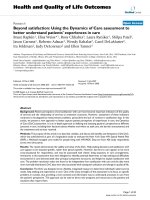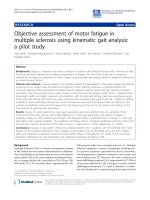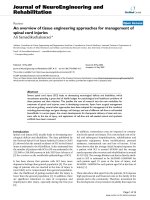Báo cáo hóa học: " An assessment of the effect of hepatitis B vaccine in decreasing the amount of hepatitis B disease in Italy" pptx
Bạn đang xem bản rút gọn của tài liệu. Xem và tải ngay bản đầy đủ của tài liệu tại đây (252.66 KB, 7 trang )
BioMed Central
Page 1 of 7
(page number not for citation purposes)
Virology Journal
Open Access
Research
An assessment of the effect of hepatitis B vaccine in decreasing the
amount of hepatitis B disease in Italy
Giuseppe La Torre*, Nicola Nicolotti, Chiara de Waure,
Giacomina Chiaradia, Maria Lucia Specchia, Alice Mannocci and
Walter Ricciardi
Address: Catholic University of the Sacred Heart, Institute of Hygiene, Rome, Italy
Email: Giuseppe La Torre* - ; Nicola Nicolotti - ; Chiara de Waure - ;
Giacomina Chiaradia - ; Maria Lucia Specchia - ;
Alice Mannocci - ; Walter Ricciardi -
* Corresponding author
Abstract
Background: Hepatitis B (HBV) infection is an important cause of morbidity and mortality and it
is associated to a higher risk of chronic evolution in infected children. In Italy the anti-HBV
vaccination was introduced in 1991 for newborn and twelve years old children. Our study aims to
evaluate time trends of HBV incidence rates in order to provide an assessment of compulsory
vaccination health impact.
Method: Data concerning HBV incidence rates coming from Acute Viral Hepatitis Integrated
Epidemiological System (SEIEVA) were collected from 1985 to 2006. SEIEVA is the Italian
surveillance national system that registers acute hepatitis cases. Time trends were analysed by
joinpoint regression using Joinpoint Regression Program 3.3.1 according to Kim's method. A
joinpoint represents the time point when a significant trend change is detected. Time changes are
expressed in terms of the Expected Annual Percent Change (EAPC) with 95% confidence interval
(95% CI).
Results: The joinpoint analysis showed statistically significant decreasing trends in all age groups.
For the age group 0–14 EAPC was -39.0 (95% CI: -59.3; -8.4), in the period up to 1987, and -12.6
(95% CI: -16.0; -9.2) thereafter. EAPCs were -17.9 (95% CI: -18.7; -17.1) and -6.7 (95% CI: -8.0; -
5.4) for 15–24 and ≥25 age groups, respectively. Nevertheless no joinpoints were found for age
groups 15–24 and ≥25, whereas a joinpoint at year 1987, before compulsory vaccination, was
highlighted in 0–14 age group. No joinpoint was observed after 1991.
Discussion: Our results suggest that the introduction of compulsory vaccination could have
contribute partly in decreasing HBV incidence rates. Compulsory vaccination health impact should
be better investigated in future studies to evaluate the need for changes in current vaccination
strategy.
Published: 24 July 2008
Virology Journal 2008, 5:84 doi:10.1186/1743-422X-5-84
Received: 30 April 2008
Accepted: 24 July 2008
This article is available from: />© 2008 La Torre et al; licensee BioMed Central Ltd.
This is an Open Access article distributed under the terms of the Creative Commons Attribution License ( />),
which permits unrestricted use, distribution, and reproduction in any medium, provided the original work is properly cited.
Virology Journal 2008, 5:84 />Page 2 of 7
(page number not for citation purposes)
Background
HBV infection is an important cause of morbidity and
mortality. The World Health Organisation (WHO) esti-
mates that two billion of people worldwide have a sero-
logical evidence of past or present HBV infection [1].
The prevalence of chronic HBV infection is low (<2%) in
the general population in Northern and Western Europe,
North America, Australia, New Zealand, Mexico, and
Southern South America. The prevalence of chronic HBV
infection is intermediate (2%–7%) in South Central and
Southwest Asia, Israel, Japan, Eastern and Southern
Europe, Russia, most areas surrounding the Amazon River
basin, Honduras, and Guatemala. The prevalence of
chronic HBV infection is high (>8%) in all Countries in
Africa, Southeast Asia, the Middle East (except Israel),
Southern and Western Pacific islands, the interior Ama-
zon River basin and certain parts of the Caribbean (Haiti
and the Dominican Republic) [2].
In Italy, the prevalence of HBV infection is set under 2%
from the beginning of the twentieth. The most important
routes of transmission are sexual intercourse, intrafamiliar
contacts and i.v. drug use [3]. The HBV infection trend is
changed through the years. There were two important
downward tendencies in the serum prevalence of infec-
tion, one at the beginning of the eighties, related to the
improved socio-economic conditions and to the reduc-
tion in family numerousness [4], and one at the end of the
eighties, after the spreading of HIV infection and before
compulsory vaccination.
In 1985, the Acute Viral Hepatitis Integrated Epidemio-
logic System data (SEIEVA) was established [5]. The
national surveillance system underlined an impressive
reduction of the incidence of HBV infection from 12/
100,000 to 5.1/100,000 through the 1985–1991 period,
reporting the highest number of cases among individuals
15–24 years old and among males [6]. From the starting
of compulsory vaccination campaign, in 1991, there was
another downfall in HBV incidence with a reduction of
40% from 1988–91 to 1991–99. The incidence reduction
was of 66% among 0–14 years old individuals and 59%
among 15–24 years old ones [6].
The compulsory vaccination was mainly introduced by
the high risk of chronic evolution of the infection in chil-
dren. SEIEVA data demonstrated a stabilisation of the epi-
demiological trend of infection with a mean incidence of
1.65 cases for 100,000 in the last 6 years available [7]; this
trend was also demonstrated in other European nations
[8].
Anti-hepatitis B vaccine has still some aspects, such as the
immunity memory length and the failure rate, to go in
deep [9,10].
Our study aims to evaluate the epidemiology of HBV
infection in Italy and to provide an assessment of compul-
sory vaccination health impact by studying time trends
through the use of the joinpoint regression. This statistical
technique highlights the time points that divide periods
characterised by different time trends. It should so repre-
sent an innovative approach to in depth investigate the
HBV incidence rates decreasing trends described by other
authors [6,8,11-14] and to give some additional insight to
the vaccine impact.
Methods
Data and setting
HBV incidence rates, reported by the SEIEVA, were col-
lected from 1985 to 2006 [7]. SEIEVA is a surveillance sys-
tem that covers 57% of Italian population and aims to
investigate epidemiology of viral acute hepatitis. The sys-
tem is coordinated by the National Institute of Health and
each Local Health Unit (LHU) can join voluntary the sys-
tem.
Data regarded incidence rates for 100,000 and were strat-
ified by age (0–14; 15–24; ≥ 25). Rates were computed
dividing the number of cases by the total population of
each joining LHU. In the surveillance system the diagnosis
of acute hepatitis B was posed if a serologically confirmed
positivity for IgM anti-HBcAg was found.
Since SEIEVA data were available before mass vaccination
introduction for the period 1985–1991, study of time
trend changes was made possible.
In Italy another national database on HBV infections
(SIMI) exists from Italian Public Health Ministry [15].
However, this database is not exclusively devoted to this
type of infection, but covers all notifiable infectious dis-
eases. We were not allowed to perform the same evalua-
tion, done with SEIEVA surveillance, since SIMI data were
available from 1996 only.
Statistical analysis
The analysis on SEIEVA data was carried out for three dif-
ferent age groups (0–14; 15–24; over 25 years) and for all
ages together. Incidence rates time trends were analysed
by joinpoint regression according to Kim's method [16].
The following formula was used for the logarithmic trans-
formation of incidence rates:
ln(y) = bx
Virology Journal 2008, 5:84 />Page 3 of 7
(page number not for citation purposes)
where x represents the calendar years, b is the regression
coefficient and y the incidence rate.
A joinpoint represents the time point when a significant
trend change is detected. Time changes are expressed in
terms of Expected Annual Percent Change (EAPC) with
respective 95% confidence interval; significance level of
time trends is also reported. The null hypothesis was
tested using a maximum of three changes in slope with an
overall significance level of 0.05 divided by the number of
join-points in the final model.
For the analysis we used the Joinpoint Regression Pro-
gram, Version 3.3.1 [17].
Results
In the 1985–2006 period a strong reduction of hepatitis B
incidence rates in all age groups was observed (Figure 1).
SEIEVA data showed the highest incidence rates of hepati-
tis B in individuals belonging to the 15–24 and ≥25 age
groups. The incidence rate reduction goes from 6.00 to
0.02 for 100,000 in the age class 0–14, from 41.00 to 0.50
in the group 15–24 years and from 7.00 to 2.30 in indi-
viduals of 25 years or more, in the period 1985–2006.
Considering all the age groups, the incidence rate
decreased from 12 for 100,000 to 1.6 for 100,000.
The joinpoint analysis showed a statistically significant
decrease of HBV infection incidence rates too, in particu-
lar in 0–14 and 15–24 age groups.
For the age group 0–14 the analysis highlighted a join-
point at year 1987; EAPC changed from -39.0 (95% CI: -
59.3; -8.4), in the period up to 1987, to -12.6 (95% CI: -
16.0; -9.2) thereafter thus meaning that from 1987 HBV
incidence rates showed a significant overall annual
decrease of 12.6% (Table 1).
No joinpoints were found for the other age groups. EAPCs
were -17.9 (95% CI: -18.7; -17.1) and -6.7 (95% CI: -8.0;
-5.4) for 15–24 and ≥25 age groups: HBV incidence rates
Incidence rates (for 100,000) of HBV infection in Italy, 1985–2006Figure 1
Incidence rates (for 100,000) of HBV infection in Italy, 1985–2006.
Table 1: EAPC and 95% CI
Age group Years range EAPC (%) 95% CI p-value
0–14 1985–1987 -39.0 (-59.3; -8.4) 0.02
1987–2006 -12.6 (-16.0; -9.2) <0.001
15–24 1985–2006 -17.9 (-18.7; -17.1) <0.001
Over 25 1985–2006 -6.7 (-8.0; -5.4) <0.001
All 1985–1992 -15.6 (-18.4; -12.8) <0.001
1992–2006 -7.1 (-9.0; -5.1) <0.001
Virology Journal 2008, 5:84 />Page 4 of 7
(page number not for citation purposes)
showed an annual decrease of 17.6% and 6.7% respec-
tively (Table 1).
On the other hand, considering all age groups a joinpoint
at year 1992 was detected; overall annual decrease was of
15.6% (95% CI: -18.4; -12.8) before 1992 and 7.1% (95%
CI: -9.0; -5.1) thereafter (Table 1).
Time trend changes are illustrated in Figures 2, 3, 4 and 5.
Discussion
Hepatitis B incidence rates decreased in each age group
throughout the period considered.
Joinpoint regression for 15–24 age groupFigure 3
Joinpoint regression for 15–24 age group.
Joinpoint regression for 0–14 age groupFigure 2
Joinpoint regression for 0–14 age group.
Virology Journal 2008, 5:84 />Page 5 of 7
(page number not for citation purposes)
From the analysis of time trends, it is possible to suppose
that the reduction of HBV incidence rates was influenced
not only by mass vaccination. Moreover, considering that
vaccination coverage reached about 95% since 1991 [18],
other factors (i.e. different lifestyles, new hygiene rules
and the introduction of different systems of prevention
such as the blood screening and the use of precautions in
medical setting), besides vaccination campaign, could
have contributed to the decrease of HBV infections.
According to the joinpoint analysis of SEIEVA data, a sta-
tistically significant change in HBV incidence rates time
trend was found, before the introduction of compulsory
vaccination, for the age group 0–14 (up to 1087). In par-
Joinpoint regression for all agesFigure 5
Joinpoint regression for all ages.
Joinpoint regression for 25+ age groupFigure 4
Joinpoint regression for 25+ age group.
Virology Journal 2008, 5:84 />Page 6 of 7
(page number not for citation purposes)
ticular, a smaller decrease of HBV incidence rates in the
following period (1987–2005) than in the first one
(1985–1987) was observed. Nevertheless, in this age
group, prevalence rates of HBV serological markers were
estimated to be low in low/intermediate endemic areas
for the infection [19]. Moreover, the decrease of HBV inci-
dence rates before compulsory vaccination could be
related to the strongly recommendation of HBsAg screen-
ing for pregnant women during the last trimester of preg-
nancy since 1984 [20]. In low/intermediate endemic
areas, such as Italy as a whole, and such as the other
Southern Mediterranean European regions, horizontal
transmission is the main way of acquiring infection thus
determining the highest HBV incidence rates among
adults [21]. Improved sanitation, obtained with the use of
universal precautions in medical settings and blood
screening, social, behavioural and demographic changes
and sexual educational campaigns seem yet to have been
effective to reduce horizontal transmission in these coun-
tries and there are some evidences that the highest HBV
incidence rates have to be expected in adults older than 50
[19,22]. These same changes could be positively associ-
ated to the decrease of HBV incidence rates observed
among people from 15 to 24 years of age and in 25 years
or older people. HBV incidence rates have progressively
decreased through the years in all age groups, even if
EAPC was smaller in over 25 years old than in the other
groups. The incidence rate reduction in over 25 years peo-
ple could be also partly attributed to the herd immunity
induced by the high coverage rate of children immunisa-
tions [23].
The introduction of compulsory vaccination has deter-
mined a reduction of HBV incidence rates and this
decrease, according to our analysis, could have been influ-
enced not only by primary prevention sustained by vacci-
nation stategies. This could be also sustained from the
evidence of a joinpoint at the year 1992. After this year
there was a smaller decrease in HBV incidence rates than
before. Moreover, the vaccination of high risk adults, such
as injection drugs users and persons at risk of sexual trans-
mission, should be promoted. In fact, there are evidences
that these groups of adults, despite of recommendations,
are not used to be vaccinated [24,11,12]. This is also con-
firmed by EAPC value.
Our study has some strenght and limitations. As far as
concerns the former ones, this is the first time that the
Joinpoint regression model was used in assessing the time
trends of a particular infectious in Italy, thus allowing to
give some insight to effectiveness of a specific vaccination
campaign. The principal limit of our study was concerning
the internal validity: unfortunately there is a lack of data
before 1985, that could have helped us to better estimate
time trend changes in HBV incidence rates. Finally,
another problem is related to external validity: the use of
SEIEVA data system that could not completely represent
the national epidemiological setting. Nevertheless, it
should be considered that the wide distribution of LHUs
allows standard approaches and procedures to anti-HBV
vaccination [13].
This study still underlines the importance of a correct and
exhaustive data collection in a surveillance system to real-
ise survey on efficacy of public health interventions.
Since the results of this study could be considered prelim-
inary, we would suggest to carry out new evidences about
anti-HBV vaccine health impact to evaluate the possible
need to modify current vaccination strategy.
Authors' contributions
GLT designed the study and guided the statistical analysis.
NN and CdW collected data and performed the statistical
analysis. GC and MLS drafted the manuscript. AM verified
the results. WR coordinated the working group and
reviewed the paper. All authors read and approved the
final manuscript.
References
1. Shepard CW, Simard EP, Finelli L, Fiore AE, Bell BP: Hepatitis B
Virus Infection: Epidemiology and vaccination. Epidemiol Rev
2006, 28:112-125.
2. Centers for Disease Control and Prevention. US Department of
Health and Human Services, Public Health Service: Health Information
for International Travel 2008. Atlanta 2007.
3. Stroffolini T: The changing pattern of hepatitis B virus infec-
tion over the past three decades in Italy. Dig Liver Dis 2005,
37:622-627.
4. Crovari P: Epidemiology of viral hepatitis B in Italy. Vaccine
1995, 13(suppl 1):S26-S30.
5. Mele A, Rosmini F, Zampieri A, Gill ON: Integrated epidemiolog-
ical system for acute viral hepatitis in Italy (SEIEVA):
description and preliminary results. Eur J Epidemiol 1986,
2(4):300-304.
6. Stroffolini T, Mele A, Tosti ME, Gallo G, Balocchini E, Ragni P, Santo-
nastasi F, Marzolini A, Ciccozzi M, Moiraghi A: The impact of the
hepatitis B mass immunisation campaign on the incidence
and risk factors of acute hepatitis B in Italy. J Hepatol 2000,
33:980-985.
7. ISS. Acute Viral Hepatitis Integrated Epidemiologic System
data (SEIEVA) [ />tab06_2.1184669248.pdf]
8. Salleras L, Dominguez A, Bruguera M, Cardeñosa N, Batalla J, Car-
mona G, Navas E, Taberner JL: Dramatic decline in acute hepa-
titis B infection and disease incidence rates among
adolescents and young people after 12 years of a mass hepa-
titis B vaccination programme of pre-adolescents in the
schools of Catalonia (Spain). Vaccine 2005, 23:2181-2184.
9. Hammitt LL, Hennessy TW, Fiore AE, Zanis C, Hummel KB, Duna-
way E, Bulkow L, McMahon BJ: Hepatitis B immunity in children
vaccinated with recombinant hepatitis B vaccine beginning
at birth: a follow-up study at 15 years. Vaccine 2007,
25(39–40):6958-64.
10. Gabbuti A, Romanò L, Blanc P, Meacci F, Amendola A, Mele A, Maz-
zotta F, Zanetti AR: Long-term immunogenicity of hepatitis B
vaccination in a cohort of Italian healthy adolescents. Vaccine
2007, 25(16):3129-32.
11. Mele A, Tosti ME, Mariano A, Pizzuti R, Ferro A, Borrini B, Zotti C,
Lopalco P, Curtale F, Balocchini E, Spada E, National Surveillance Sys-
tem for Acute Viral Hepatitis (SEIEVA) Collaborating Group: Acute
hepatitis B 14 years after the implementation of universal
Publish with BioMed Central and every
scientist can read your work free of charge
"BioMed Central will be the most significant development for
disseminating the results of biomedical research in our lifetime."
Sir Paul Nurse, Cancer Research UK
Your research papers will be:
available free of charge to the entire biomedical community
peer reviewed and published immediately upon acceptance
cited in PubMed and archived on PubMed Central
yours — you keep the copyright
Submit your manuscript here:
/>BioMedcentral
Virology Journal 2008, 5:84 />Page 7 of 7
(page number not for citation purposes)
vaccination in Italy: areas of improvement and emerging
challenges. Clin Infect Dis 2008, 46(6):868-75.
12. Spada E, Mele A, Ciccozzi M, Tosti ME, Bianco E, Szklo A, Ragni P,
Gallo G, Balocchini E, Sangalli M, Lopalco PL, Moiraghi A, Stroffolini
T, SEIEVA collaborating group: Changing epidemiology of
parenterally transmitted viral hepatitis: results from the
hepatitis surveillance system in Italy. Dig Liver Dis 2001,
33(9):778-84.
13. FitzSimons D, Vorsters A, Hoppenbrouwers K, Van Damme P: Pre-
vention and control of viral hepatitis through adolescent
health programmes in Europe. Vaccine 2007, 25:8651-8659.
14. Da Villa G, Romanò L, Sepe A, Iorio R, Paribello N, Zappa A, Zanetti
AR: Impact of hepatitis B vaccination in a highly endemic
area of south Italy and long-term duration of anti-HBs anti-
body in two cohorts of vaccinated individuals. Vaccine 2007,
25:3133-3136.
15. Italian Public Health Ministry (SIMI) [ />bancaDati.aspx]
16. Kim HJ, Fay MP, Feuer EJ, Midthune DN: Permutation tests for
joinpoint regression with applications to cancer rates. Stat
Med 2000, 19:335-351.
17. Joinpoint Regression Program, Version 3.3.1, April 2008.
Statistical Research and Applications Branch, National Can-
cer Institute [ />]
18. WHO – Immunization surveillance, assessment and moni-
toring [ />coverage_series.xls]
19. Stroffolini T, Guadagnino V, Chionne P, Procopio B, Mazzuca EG,
Quintieri F, Scerbo P, Giancotti A, Nisticò S, Focà A, Tosti ME, Rapi-
cetta M: A population based survey of hepatitis B virus infec-
tion in a southern Italian town. Ital J Gastroenterol Hepatol 1997,
29:415-9.
20. Stroffolini T, Bianco E, Szklo A, Bernacchia R, Bove C, Colucci M,
Cristina Coppola R, D'Argenio P, Lopalco P, Parlato A, Ragni P,
Simonetti A, Zotti C, Mele A: Factors affecting the compliance
of the antenatal hepatitis B screening programme in Italy.
Vaccine 2003, 21(11–12):1246-9.
21. Custer B, Sullivan SD, Hazlet TK, Iloeje U, Veenstra DL, Kowdley KV:
Global epidemiology of Heaptitis B virus. J Clin Gastroenterol
2004, 38(Suppl 3):S158-S168.
22. Bolke E, Flehmig B: New epidemiologic patterns of hepatitis A
and B infections in Germany. Zentralbl Hyg Umweltmed 1995,
196:511-514.
23. Da Villa G, Romanò L, Sepe A, Iorio R, Paribello N, Zappa A, Zanetti
AR: Impact of hepatitis B vaccination in a highly endemic
area of south Italy and long-term duration of anti-HBs anti-
body in two cohorts of vaccinated individuals. Vaccine 2007,
25(16):3133-6.
24. Hepatitis B vaccine coverage among adults – United States,
2004. MMWR Morb Mortal Wkly Rep 2006, 55:509-11.
